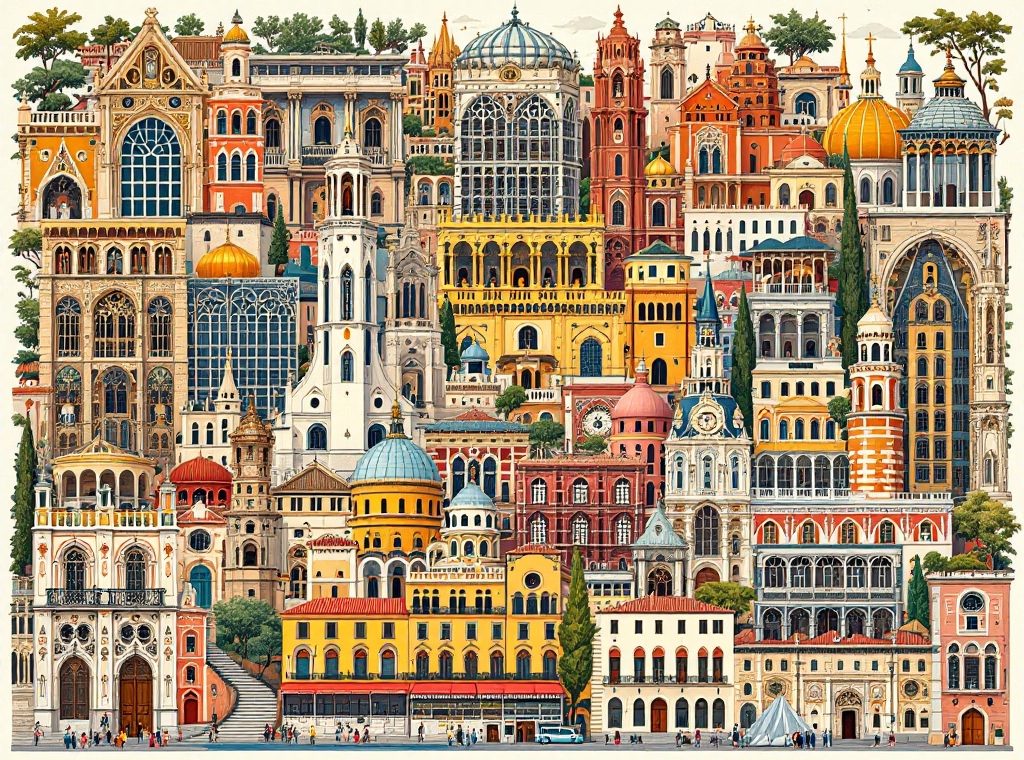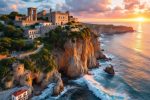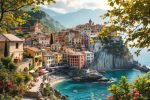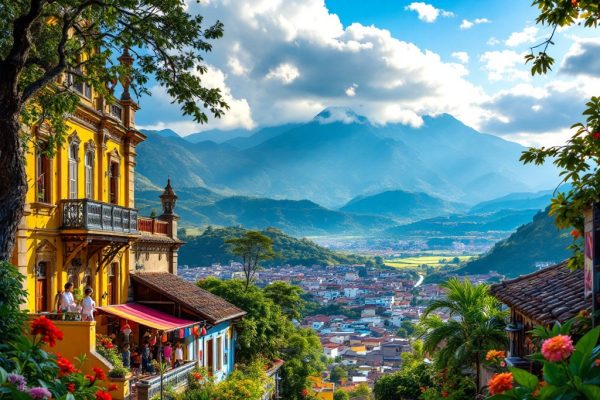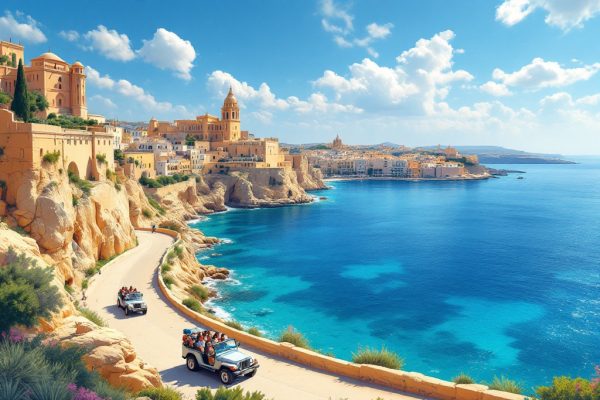Discovering History and Charm: The Best Cities in Spain to Visit
Dreaming of Spain? From vibrant Barcelona’s blend of Gothic and Modernist architecture to the historical charm of Madrid’s Royal Palace and Prado Museum, uncover the magic of Spain’s best cities. Explore Seville’s flamenco rhythms and Moorish marvels, Granada’s breathtaking Alhambra, and Valencia’s futuristic City of Arts and Sciences. Discover ancient ruins in Cádiz, architectural wonders in Segovia, and the unique Hanging Houses of Cuenca. Uncover the rich history and vibrant culture – start planning your Spanish adventure today!
Important information

- Spain offers diverse cities rich in history and culture, from Barcelona’s blend of Gothic and Modernist architecture to Madrid’s world-class museums like the Prado.
- Several cities showcase stunning Moorish heritage: Seville boasts the Alcázar and Giralda, Granada the Alhambra and Generalife, and Ronda the Puente Nuevo and Baños Arabes.
- Unique architectural marvels are scattered throughout Spain: Cuenca’s Hanging Houses, Segovia’s Roman Aqueduct, and Bilbao’s Guggenheim Museum.
- Coastal Málaga combines history (Roman Theatre, Alcazaba) with seaside relaxation and Picasso’s art, while Pamplona offers the thrilling Running of the Bulls alongside historical sites.
- Toledo, the “City of Three Cultures,” displays a captivating blend of Christian, Muslim, and Jewish influences, notably in its Jewish Quarter and Mosque-Cathedral.
Discovering History and Charm: The Best Cities in Spain to Visit
Barcelona seamlessly blends Gothic and Modernist architecture.
In Madrid, immerse yourself in culture and history at landmarks like the Royal Palace and Prado Museum.
Seville vibrates with flamenco rhythms, showcasing Moorish architecture in the Reales Alcázares and Giralda.
Granada is home to the breathtaking Alhambra Palace and the tranquil Generalife Gardens.
Valencia offers a compelling mix of futuristic designs and historic sites.
Bilbao thrives as an art hub, anchored by the Guggenheim Museum and the charming Casco Viejo.
Toledo, a city shaped by three cultures, boasts a historic Jewish Quarter and the unique Mosque-Cathedral.
Córdoba reveals a fascinating history through the Mezquita and Roman Bridge.
Santiago de Compostela, the culmination of many pilgrimages, features a grand cathedral.
Cádiz, one of Europe’s oldest cities, holds ancient ruins and monuments.
Segovia’s remarkable Roman Aqueduct and Alcázar are must-sees.
Ronda offers picturesque towns and stunning Moorish architecture, highlighted by the Puente Nuevo.
Málaga combines rich history with seaside relaxation, inviting exploration of the Roman Theatre, Alcazaba, and Picasso Museum.
Pamplona, famous for the Running of the Bulls, also possesses significant historical sites.
Cuenca stands out with its unique Hanging Houses and historic city center.
Barcelona: A Blend of Gothic and Modernist Architecture
Barcelona’s allure comes from its unique architectural landscape, a captivating blend of Gothic and Modernist styles. The Gothic Quarter, with its medieval streets and historical landmarks, is a must-see for any visitor. Barcelona’s Modernist movement, spearheaded by Antoni Gaudí, is equally compelling. His iconic Sagrada Família and Park Güell are prime examples of this artistic innovation. This, combined with the city’s distinct Mediterranean atmosphere, makes Barcelona a truly special destination in Spain, showcasing a remarkable fusion of history and modern artistry.
Gothic Quarter: Medieval Streets and Landmarks
Barcelona’s Gothic Quarter draws visitors into a labyrinth of narrow medieval streets, lined with ancient buildings that whisper tales of the city’s rich past. It’s a captivating journey through time.
Sagrada Familia: Gaudí’s Masterpiece
Antoni Gaudí’s Sagrada Familia, a UNESCO World Heritage site, is a stunning blend of Gothic and Art Nouveau architecture. Its intricate facades depict biblical scenes. The central nave vaults soar to a breathtaking 150 feet. Construction began in 1882, and completion isn’t expected until 2026, a testament to Gaudí’s enduring architectural vision.
Madrid: A Cultural and Historical Experience
Madrid seamlessly blends history, culture, and a vibrant modern atmosphere. Explore world-class museums like the Prado and architectural wonders such as the Royal Palace, the Spanish Royal Family’s official residence. Experience local life in bustling plazas like Plaza Mayor, creating a unique cultural immersion.
Royal Palace
One of Europe’s largest palaces, the Royal Palace, serves as a symbol of the Spanish monarchy. It is used for state ceremonies rather than official state functions.
Prado Museum
Journey through art history at the Prado Museum. Its vast collection of European paintings, spanning from the 12th to the early 19th century, features Spanish, Italian, and Flemish masterpieces by renowned artists like Goya, Velázquez, and El Greco.
Royal Palace: A Symbol of Spain’s Monarchy
The Royal Palace of Madrid is the official residence of the Spanish Royal Family and the site of important state ceremonies. However, it’s not their actual home; they reside elsewhere.
Prado Museum: Art and Culture
The Prado Museum in Madrid is renowned for its vast collection of European art, spanning from the 12th to the early 20th century. While the museum showcases a broad spectrum of European art history, it is particularly celebrated for its impressive holdings of Spanish masters. These include iconic works by Velázquez and Goya. A visit to the Prado is essential for any art enthusiast.
Seville: Flamenco Rhythms and Moorish Architecture
Seville, Spain, pulsates with flamenco rhythms and Moorish artistry. At its heart lie architectural marvels, including the Seville Cathedral, a Gothic masterpiece among the world’s largest, and the Alcázar of Seville, a royal palace echoing its Moorish heritage. The city’s vibrant spirit also finds expression in its famed festivals, such as the Feria de Abril and Semana Santa.
The Reales Alcazares
The Reales Alcazares stands as a breathtaking royal palace, showcasing stunning Moorish architecture. Its intricate details and lush gardens whisper tales of Seville’s rich and diverse past.
The Giralda
Once a minaret, the Giralda now graces the Seville Cathedral as its iconic bell tower. Ascend to its peak for panoramic city views, an unforgettable experience.
Reales Alcazares: A Moorish Marvel
Seville’s Reales Alcázares is a striking royal palace, originally constructed by Moorish Muslim kings. The palace boasts stunning Islamic architecture and expansive gardens providing a tranquil retreat.
Giralda: Iconic Bell Tower
Seville’s iconic Giralda bell tower boasts a captivating past, originating as a minaret during the Moorish era. This is a testament to the city’s rich cultural heritage.
Granada: Home to the Alhambra Palace
Granada, home to the magnificent Alhambra Palace, is a city that truly shines. This UNESCO World Heritage site is a marvel of Moorish architecture, brimming with intricate details. The adjacent Generalife Gardens offer a tranquil escape with breathtaking views of the city, further showcasing the Moorish influence. Together, the Alhambra Palace and Generalife Gardens tell a compelling story of Spain’s rich Moorish heritage.
Alhambra Palace: A Testament to Moorish Influence
The Alhambra, a UNESCO World Heritage site, showcases stunning Moorish art and architecture. Known for its intricate tilework, ornate stucco, and serene courtyards, the palace complex is remarkably beautiful. Beyond its architectural wonders, the Alhambra offers the adjacent Generalife gardens, providing breathtaking views and a tranquil atmosphere with their peaceful fountains. These gardens offer a welcome contrast to the palace’s grandeur. Together, the Alhambra and Generalife create an unforgettable experience.
Generalife Gardens: Serenity and Beauty
The Generalife Gardens, a stunning showcase of natural splendor, served as the summer retreat for the Nasrid rulers. Part of the Alhambra, a UNESCO World Heritage site, the Generalife offers breathtaking beauty.
Valencia: Future Meets Tradition
Valencia seamlessly blends historic charm with modern marvels. The City of Arts and Sciences, with its futuristic architecture, exemplifies this contemporary flair. Valencia also treasures its rich heritage, as seen in stunning landmarks like the Valencia Cathedral and Silk Exchange. Adding to its allure is the Oceanogràfic, Europe’s largest aquarium, offering a glimpse into the wonders of marine life. Valencia also boasts beautiful beaches and vibrant festivals, including the renowned Las Fallas, making it a truly unique and captivating destination.
City of Arts and Sciences: Futuristic Architecture
Valencia’s City of Arts and Sciences displays stunning futuristic architecture, featuring engaging museums and attractions. Its modern design creates a striking contrast with Valencia’s historical center. Here, magnificent Gothic structures such as the Cathedral and Silk Exchange showcase the city’s rich past, complementing its modern marvels.
Historic Sites and Modern Attractions
Valencia seamlessly merges historical charm with modern innovation. A prime example is the City of Arts and Sciences, a futuristic complex where visitors can explore the wonders of science and culture through interactive exhibits and marvel at its breathtaking architecture. Valencia’s rich history is equally captivating. The Valencia Cathedral stands as a prominent historical landmark, while the Silk Exchange, a UNESCO World Heritage site, offers a glimpse into the city’s vibrant past.
Bilbao: A Hub for Art and Culture
Bilbao seamlessly blends Basque tradition with modern innovation. Its iconic Guggenheim Museum, a stunning titanium structure by Frank Gehry, showcases cutting-edge art. But Bilbao offers more than just architectural marvels. The Casco Viejo, the city’s historic heart, invites exploration. Discover its charming streets, lively pintxo bars, and the bustling Ribera Market, a vibrant center of local life. Bilbao’s unique character permeates every corner.
Guggenheim Museum: Modern Art Landmark
The Guggenheim Museum Bilbao displays a remarkable collection of modern and contemporary art. Its iconic architecture, a masterpiece by Frank Gehry, has not only revitalized Bilbao’s economy but also transformed its cultural landscape. The museum stands as a landmark achievement in architectural innovation.
Casco Viejo: The Old Town
Bilbao’s Casco Viejo, or old town, captivates visitors with its charming streets and unique shops, reflecting a rich cultural heritage.
Toledo: A City of Three Cultures
Toledo, known as the “City of Three Cultures,” showcases a captivating blend of Christian, Muslim, and Jewish influences. This rich history is woven into the very fabric of the city’s architecture and landmarks.
The Jewish Quarter
The Jewish Quarter whispers tales of Toledo’s vibrant Jewish community. Synagogues like El Tránsito and Santa María la Blanca stand as magnificent testaments to their enduring legacy and architectural prowess.
The Mosque-Cathedral
The Mosque-Cathedral of Toledo is a truly unique landmark, seamlessly blending Islamic and Christian design elements. This architectural marvel embodies the city’s diverse past, perfectly representing its “City of Three Cultures” moniker.
Jewish Quarter: Historical Insights
Toledo’s Jewish Quarter unveils a rich tapestry of Jewish life in Spain. Explore magnificent synagogues such as El Tránsito and Santa María la Blanca, architectural gems that stand as testaments to a vibrant past. Lose yourself in the labyrinthine streets and discover historic buildings, each whispering stories of bygone eras. A visit here offers a captivating journey through time.
Mosque-Cathedral: A Unique Blend
Toledo’s Mosque-Cathedral reflects a rich tapestry of interwoven faiths, beautifully merging Islamic and Christian architecture into a uniquely fascinating structure.
Córdoba: An Extraordinary Blend of History
Córdoba captivates visitors with its vibrant blend of Roman, Islamic, and Christian influences. This rich history is beautifully showcased in the city’s remarkable architecture. Explore iconic landmarks such as the Mezquita, a former mosque transformed into a cathedral, and the enduring Roman Bridge, a testament to ancient engineering. These monuments reveal Córdoba’s fascinating and complex past.
Mezquita: A Symbol of Islamic Influence
Córdoba’s Mezquita-Cathedral showcases the city’s rich Islamic heritage. Originally built in 784 AD as a mosque, its hypostyle hall is a breathtaking spectacle of columns and arches, evoking the image of a serene forest. Later, Renaissance and Gothic elements were incorporated, reflecting Córdoba’s intricate history and the diverse cultures that shaped its identity. The cathedral’s architecture stands as a testament to the city’s evolving character.
Roman Bridge: Ancient Engineering
Córdoba’s Roman Bridge gracefully connects the city’s vibrant present to its storied past. From this ancient marvel, visitors can enjoy breathtaking views of the surrounding area.
Santiago de Compostela: The Pilgrimage’s End
Santiago de Compostela is the culmination of the Camino de Santiago pilgrimage, drawing countless pilgrims and tourists annually. The Cathedral serves as their final and powerful destination.
Cathedral of Santiago: Pilgrim’s Destination
Pilgrims on the Camino de Santiago find their journey’s end at the grand Santiago de Compostela Cathedral, a renowned example of Romanesque architecture and a site of immense historical importance.
Cádiz: One of Europe’s Oldest Cities
Cádiz, a jewel of Western Europe, boasts a history stretching back to its founding around 1100 BC by the Phoenicians. This ancient city is a treasure trove of ruins and monuments, whispering tales of Phoenician, Roman, and Moorish civilizations. Imagine standing before remnants of Phoenician city walls or exploring the Roman theater. Cádiz offers a captivating journey through time.
Ancient Ruins and Historical Monuments
Cádiz, one of Europe’s oldest cities, invites you to explore its rich history. Journey through time as you encounter ancient ruins and monuments, each whispering tales of its captivating past. From its Phoenician origins to the influences of Roman and Moorish rule, Cádiz’s story unfolds before your eyes.
Discover Cádiz’s Historical Gems
Explore the Teatro Romano, a remarkable testament to the city’s Roman heritage. Walk along the remnants of the centuries-old city walls, imagining the lives and events they witnessed.
Breathtaking Views Await
Visit the Castillo de San Sebastián and Castillo de Santa Catalina, two historic fortresses perched on the edge of the sea. These magnificent structures offer breathtaking panoramic views of the city and the sparkling coastline.
Cádiz is a true historical treasure waiting to be discovered.
Segovia: Known for Its Ancient Aqueduct
Segovia boasts two remarkable landmarks. The first is the magnificent, remarkably well-preserved Roman aqueduct, a testament to Roman engineering. The second is the Alcázar of Segovia, a fairy-tale castle steeped in history, having served as a royal palace, state prison, and military academy.
Roman Aqueduct: A Marvel of History
The Segovia Aqueduct is a remarkable example of Roman engineering, constructed entirely without mortar. Around 20,000 granite blocks comprise this impressive structure, which once carried water from the Frío River to Segovia. At its highest point, the aqueduct reaches a height of 28.5 meters (93.5 feet) and is supported by 167 arches.
Alcazar of Segovia: Fairy Tale Castle
The Alcázar of Segovia is a striking, fairy-tale castle with an unforgettable silhouette. Perched atop a rocky crag, its commanding presence has witnessed centuries of history as a royal palace, state prison, royal artillery college, and military academy. Its unique architecture and rich history make it a must-see destination.
Ronda: Picturesque Towns and Moorish Architecture
Ronda, Spain, is renowned for the breathtaking Puente Nuevo bridge and its picturesque towns steeped in Moorish history. The city’s past is evident in its very architecture. Completed in 1793, Puente Nuevo spans the dramatic El Tajo gorge, connecting the old and new parts of Ronda. A fascinating detail is the bridge’s central chamber, which once served as a prison. Ronda’s Moorish heritage is beautifully preserved in structures like the Baños Arabes (Arab Baths), considered among Spain’s finest. The Mondragón Palace showcases exquisite Mudéjar details, while the ancient city walls and gates further reveal Ronda’s captivating Moorish past.
Puente Nuevo: The New Bridge
Completed in 1793, the Puente Nuevo offers a breathtaking view as it spans the 120-meter-deep El Tajo gorge, connecting Ronda’s historic old town with its newer counterpart. This impressive structure stands as a testament to the city’s dramatic architectural style.
Moorish Influence in Architecture
Ronda, Spain, is a beautiful city steeped in Moorish history, evident in its stunning architecture. Prime examples include the Baños Arabes (Arab Baths), Mondragón Palace, and Alminar de San Sebastián minaret. These structures boast classic Moorish features like horseshoe arches, intricate azulejo tilework, and ornate stucco ornamentation. Ronda’s urban design, particularly the narrow, winding streets of La Ciudad (the old Moorish quarter), further enhances this captivating atmosphere. This unique blend of architecture and city planning truly showcases Ronda’s rich Moorish heritage.
Málaga: Rich History and Seaside Relaxation
Málaga, a coastal city steeped in history, invites you to explore its captivating landmarks. Discover the ancient Roman Theatre and the majestic Alcazaba, where historical wonders meet coastal serenity. Art lovers can delve into the world of Pablo Picasso at the Picasso Museum, showcasing the artist’s masterpieces in his hometown.
Roman Theatre and Alcazaba
Málaga boasts two remarkable historical sites. The Roman Theatre, dating back to the 1st century BC, stands as one of the Iberian Peninsula’s oldest. Towering above is the Alcazaba, an 11th-century Moorish fortress. From the Alcazaba, visitors can enjoy stunning Mediterranean views and explore intricate Islamic architecture, complete with beautiful gardens.
Pablo Picasso Museum
The Pablo Picasso Museum in Málaga, Spain, celebrates the artist’s comprehensive body of work. Born in this vibrant city, Picasso’s artistic journey unfolds within the museum walls, showcasing diverse styles and periods. Visitors gain a rich understanding of his creative process.
Pamplona: Known for the Running of the Bulls
Pamplona is globally renowned for the Running of the Bulls, a thrilling centerpiece of the San Fermín Festival each July. However, the festival offers much more than just this adrenaline-pumping event. Religious processions, vibrant folk dancing, concerts, and bullfights all contribute to the excitement. Beyond the festivities, Pamplona’s historical sites and landmarks beckon, inviting exploration of the city’s rich past and captivating beauty.
San Fermín Festival: A Unique Experience
Pamplona’s San Fermín Festival is famous for the thrilling Running of the Bulls, but this vibrant celebration offers a much richer experience. Immerse yourself in traditional music and dance, and savor the unique local cuisine.
Historical Sites and Landmarks
Pamplona’s historical charm is evident in its impressive fortifications, including ancient walls crucial to the city’s defense. Beyond these ramparts, significant buildings further enrich Pamplona’s story. The Cathedral’s stunning architecture and the Palacio de Navarra’s glimpse into the region’s political history are prime examples. Pamplona’s heritage captivates visitors with its diverse layers.
Cuenca: Unique Hanging Houses and Architecture
Cuenca, Spain, is renowned for its Hanging Houses, dramatically perched on cliffs overlooking the Huécar River gorge. Dating back to the 15th century, these structures embody the city’s distinctive character. This unique cityscape is further enhanced by the Historic City Center, a UNESCO World Heritage site, showcasing a blend of Gothic and Renaissance architecture.These architectural marvels, seemingly defying gravity, originally served as homes. Now, some house the Museum of Spanish Abstract Art, offering a unique juxtaposition of historical architecture and modern art.A visit to Cuenca’s Historic City Center is essential. Here, you’ll discover architectural gems, including one of Spain’s earliest Gothic cathedrals, the Cuenca Cathedral. The vibrant Plaza Mayor, the city’s main square, pulsates with energy and offers a taste of local life.
Hanging Houses: Architectural Marvel
Cuenca’s Casas Colgadas, or Hanging Houses, dramatically cling to a cliff overlooking the Huécar River gorge. These iconic structures, some dating back to the 15th century, appear to defy gravity. Several of the houses now contain the Museum of Spanish Abstract Art, offering a unique blend of history and artistic expression.
Historic City Center
Cuenca’s Historic City Center, a UNESCO World Heritage site, captivates visitors with its charming cobblestone streets and numerous historic buildings, each whispering tales of the past.

